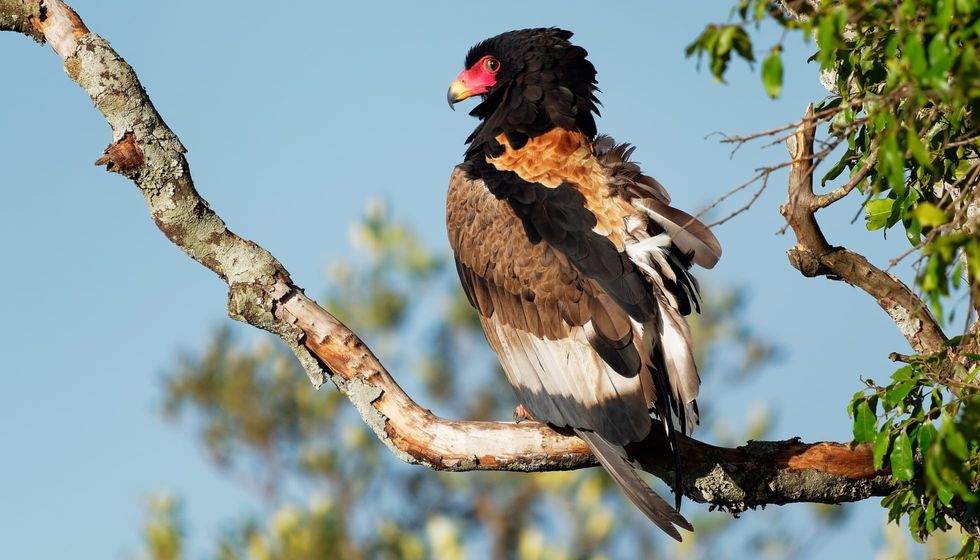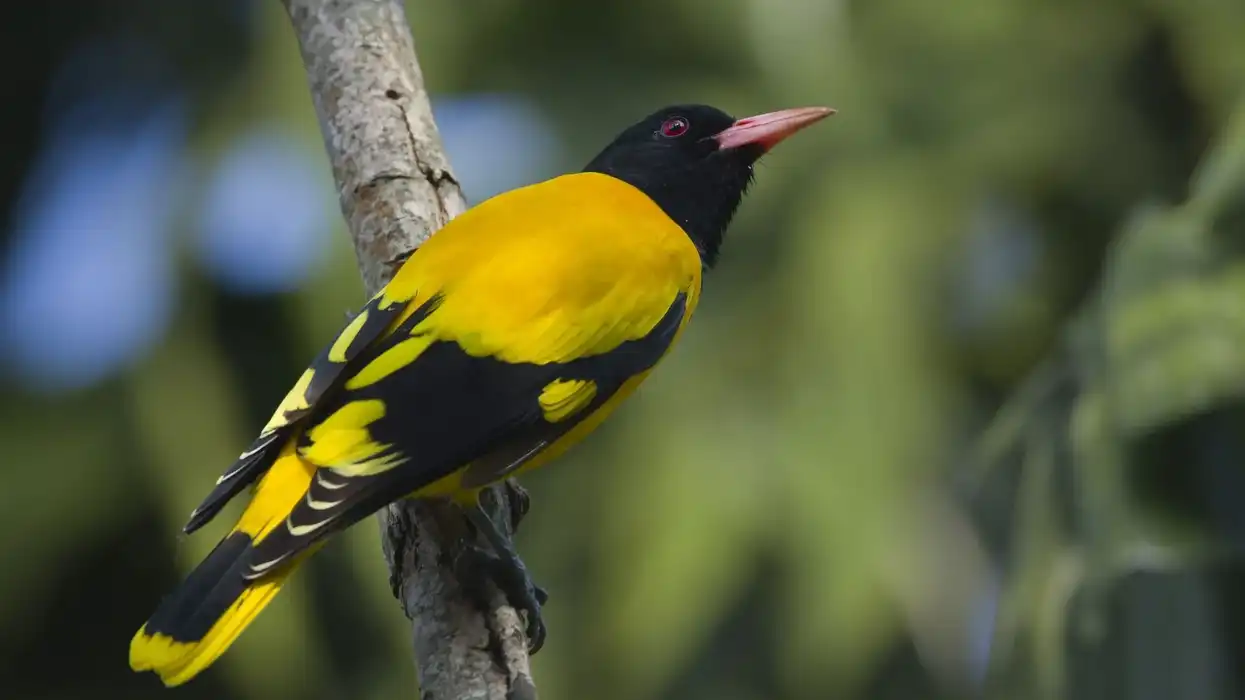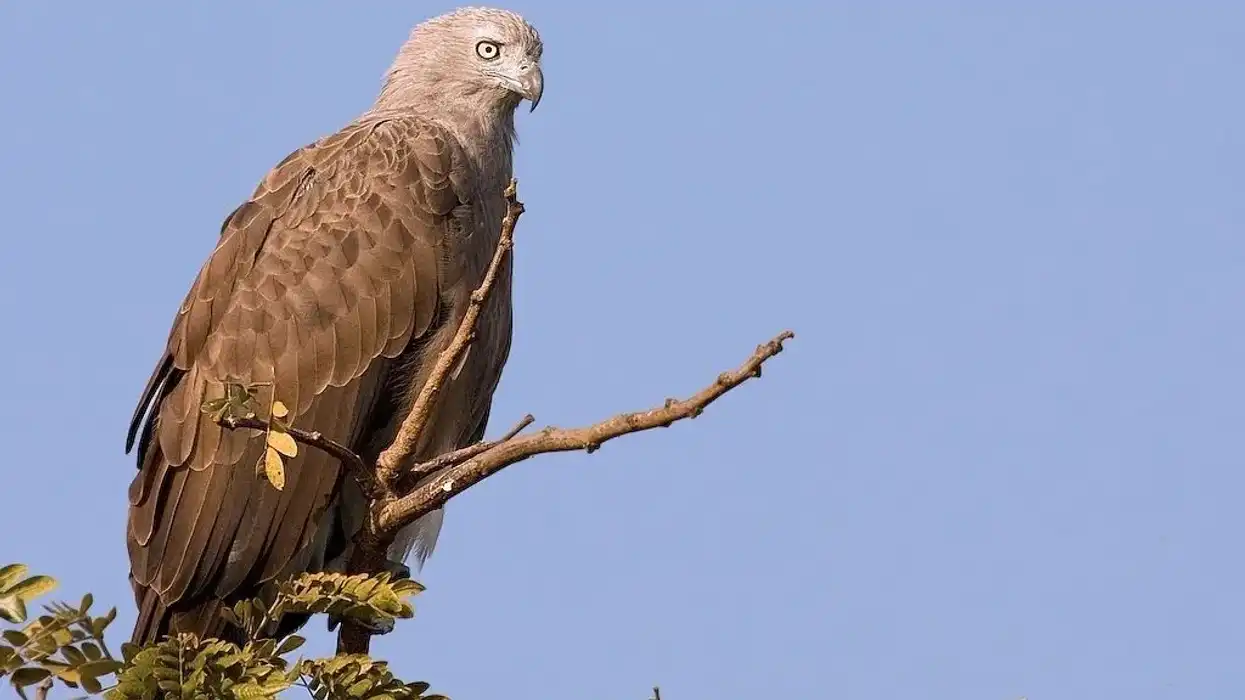The Accipitridae family includes the black-and-chestnut eagle. It is sometimes referred to as Isidor's eagle.
It is frequently assigned to the monotypic genus Oroaetus. However, current genetic research suggests that this species is closely linked to Spizaetus species, and so it should be classified as a member of that genus.
It is a medium-sized raptor found in the montane forest habitat of northern South America. Adults have mainly black plumage with chestnut on the breast and belly.
In-flight, look for big white patches in the wings and at the base of the tail, as well as chestnut in the underwing. The juvenile has a black back, white underparts, and heavily banded wings, and tail distribution.
The juvenile crested eagle is similar to the pale morph, but the wing and tail banding are thinner, and there is no barring on the breast and belly.
Single birds or pairs are most likely to be seen on bright mornings when they soar high above wooded ridges. They achieve full adult plumage in four years.
This species has a glossy black head and back with a streaky chestnut underside, wing primaries, and legs as an adult. Also, take a look at our articles on Hawaiian hawk and griffon vulture.
Black-and-Chestnut Eagle Interesting Facts
What type of animal is a black-and-chestnut eagle?
They are birds belonging to the Accipitridae family and Accipitriformes order with a wingspan of 71 in
(180.3 cm). The crested eagle is a montane forest eagle that lives in the medium to upper elevations.
What class of animal does a black-and-chestnut eagle belong to?
These species come from the class of Aves and Accipitriformes order. They were originally classified under the genus oroaetus distribution. Animals such as squirrels, monkeys, guans, and chickens are eaten by it.
How many black-and-chestnut eagles are there in the world?
The estimated population size is 250-999 mature individuals; there are several hundred eagles in Venezuela, 200 in Ecuador, a few hundred in Colombia, a tiny population in Argentina, and unknown mature individuals in Peru and Bolivia. They are listed as Endangered in the IUCN red list on the basis of their declining population range.
Where does a black-and-chestnut eagle live?
It is found in humid montane forests at altitudes ranging from 5905.6-8202.1 ft (1,800-2,500 m). They may be found in deep, undisturbed montane forest on the Andes' slopes. The black and chestnut eagle range map is usually limited to a single location (Andes mountain range) and is quite rare. Black and chestnut eagle information is not widely available.
What is a black-and-chestnut eagle's habitat?
They are found in thick, undisturbed montane forests on mountain slopes. They have been discovered in logged sections of woodland, although it is believed that they are only there due to the loss of their natural habitat.
They reside along the coasts of northwest Venezuela and northeast Colombia, as well as on the subtropical slopes of the Andes in Ecuador, Peru, Bolivia, and Argentina.
Who do black-and-chestnut eagles live with?
They live in the same area as a variety of other large forest eagles, including the lonely eagle and maybe other Spizaetus eagles, but no interactions have been recorded. The chestnut eagle (spizaetus isidori) is thought to be the top bird predator in its region.
This eagle is restricted to the east of South America, and it has an unusual but small range that extends from Venezuela through Colombia, Ecuador, Peru, and Bolivia to Argentina.
How long does a black-and-chestnut eagle live?
Chestnut eagle (spizaetus isidori) lives to an average of 18 years.
How do they reproduce?
The breeding season begins with nest building around February/March, however, this might vary according to the range, such as in Bolivia, where this breeding time happens a little later. It constructs a huge stick nest that may be up to two meters broad and one meter deep.
This massive construction is put at a high spot in emergent branches or in a tree on the ravine's side. It occasionally brings green plants to the nest. The nest may rise up to 65.7 ft (20 m) above the earth.
Spizaetus eagles typically execute aerial shows. While calling, both partners soar above the territory or conduct an undulating flight show. A single white, brown-spotted egg is deposited. It is uncertain how long the incubation phase lasts. Fledging takes between 110-130 days. Clutches contain one to two fledglings. Adults typically bring squirrels to their young in the nest area.
What is their conservation status?
Chestnut eagles (spizaetus isidori) are Endangered according to IUCN red list. The destruction of its montane forest habitat, as well as direct human persecution, are inferred to be driving a continuing decline. This eagle was uplisted from Near Threatened to Vulnerable by BirdLife International.
Black-and-Chestnut Eagle Fun Facts
What do black-and-chestnut eagle look like?
Isidor's eagle is distinguished by its black body and brownish breast, belly, and legs. The birds' tail is gray with black streaks and a black trailing border.
The basic feathers are gray, while the secondary feathers are black and barred. The bill is blackish-brown in color, with a golden cere.
The eyes are golden, and the pointed crest can grow to be 3.2-4 in (8.1-10.1 cm) long. Juveniles have a brighter gray-white head and underparts than adult birds, as well as a black crest and striping on the breast and flanks.
After four years, they achieve full adult plumage. The young bird species is distinct, being white over the head and body with a buffy wash beneath and scaly grey-brown on the back and mantle, which is slightly more widespread than in other whitish young Spizaetus.

How cute are they?
An eagle does not look to be adorable. Its towering appearance is aesthetically stunning, and it exudes a regal and noble air. They start building their nests around march.
How do they communicate?
Outside of the mating season, this eagle is fairly calm and silent. However, when the adults are near the nest, they make a loud 'pe-e-e-eo' and a high-pitched 'chee-chee-chee'.
The most typical cry is a succession of repetitive whistles like 'keeeuw... keeeuw' and 'yeeew yeeew yeeew'.
How big is a black-and-chestnut eagle?
This species is one of the biggest eagles in the Andes, only slightly smaller than the crested eagle and harpy eagle, with a body length of 24-31 in (60-80 cm) in total length. The black and chestnut eagle wingspan length is 4.82-5.91 ft (1.4-1.8 m).
How fast can a black-and-chestnut eagle fly?
An eagle's strong wingbeats enable it to soar at speeds of up to 30 mph (48.2 kph). An eagle may achieve even higher flying speeds while stooping (diving) for prey, with the bald eagle reaching a maximum dive speed of 100 mph (161 kph).
How much does a black-and-chestnut eagle weigh?
Their average weight is 10-14 lb (4.5-6.3 kg)
What are the male and female names of the species?
Both male and female members are referred to as 'eagles'.
What would you call a baby black-and-chestnut eagle?
A baby eagle is commonly referred to as an 'eaglet' or a 'fledgling'.
What do they eat?
They are known to feed mostly on mammals; monkeys (capuchins), porcupines, coatis, squirrels, and other small-to-medium-sized arboreal animals such as chickens. Guans, chickens, and other large birds are also caught. They typically have severely abraded tails as a result of diving for prey through the branches.
Are they poisonous?
An eagle will seldom if ever, attack or kill a person. An eagle's beak or strong talons can cause injury to people, although it is seldom fatal.
They have the power to kill a man, however, no such occurrence has ever been documented. They do, however, brutally assault their victim when hunting. It is perilous for their prey, particularly because their diet includes many lesser types of animals, and it is for this reason that they are classified as a bird of prey.
Would they make a good pet?
Eagles are protected by many federal laws, and keeping them as pets is unlawful. Also, because of their territorial nature, they are aggressive and unsuited as pets.
Did you know...
This hawk hunts by flying over the tops of trees. It is rarely observed perched, preferring to swoop down on the victim and through the tree limbs.
They're also known as monkeys' eaters. They also feed on many mammals like squirrels and birds like chickens.
Do black-and-chestnut eagles migrate?
There is no information regarding their migration habits.
Are black-and-chestnut eagles endangered?
It is Endangered according to the IUCN red list, mostly because its dwindling population range is considered to be quite tiny, with fewer adult individuals than previously supposed. They may be found along the coasts of northwest Venezuela and northeast Colombia, as well as on the subtropical slopes of the Andes in Ecuador, Peru, Bolivia, and Argentina.
The major reason for this species' rapid fall is the widespread destruction of primary forest habitat in the Andean foothills. Deforestation is rampant in the Andean forests, as it is throughout the tropics.
It is one of the Americas' most endangered birds of the world prey. The species' conservation concerns are exacerbated by its continuing persecution as a domestic fowl killer.
Here at Kidadl, we have carefully created lots of interesting family-friendly animal facts for everyone to discover! For more relatable content, check out these giant guitarfish facts and giant frogfish facts for kids.
You can even occupy yourself at home by coloring in one of our free printable manta ray coloring pages.
Main image by Charles J. Sharp.
*We've been unable to source an image of black-and-chestnut eagle and have used an image of a black-chested snake-eagle instead. If you are able to provide us with a royalty-free image of black-and-chestnut eagle, we would be happy to credit you. Please contact us at hello@kidadl.com.










